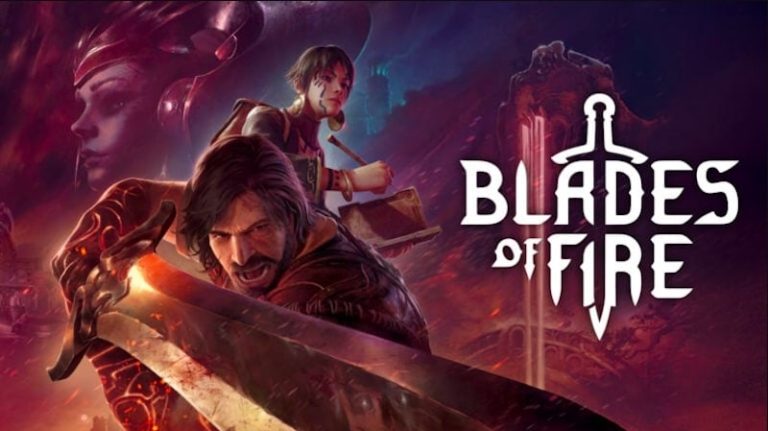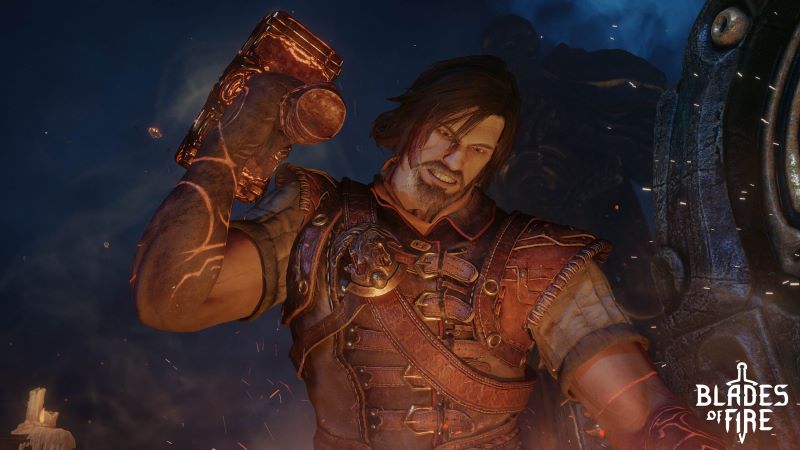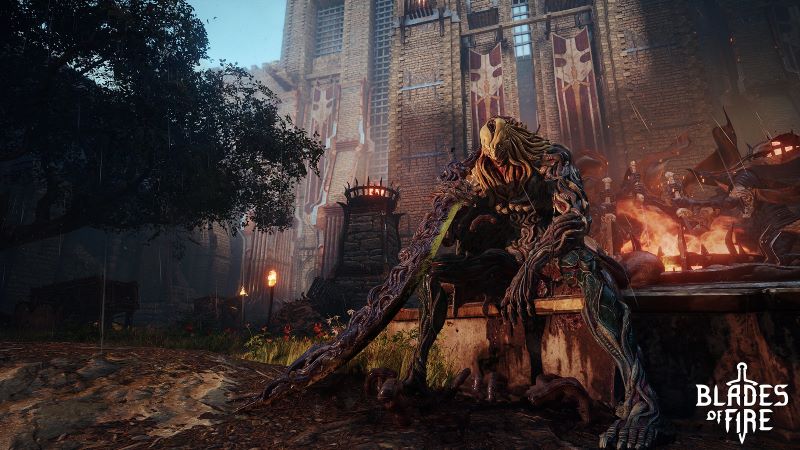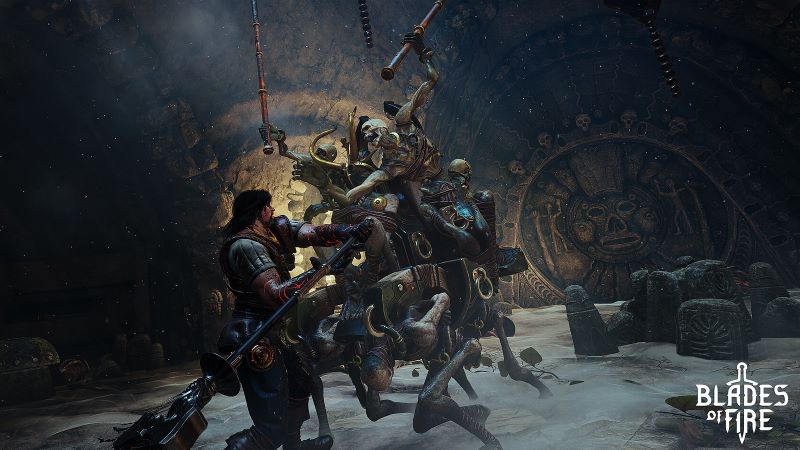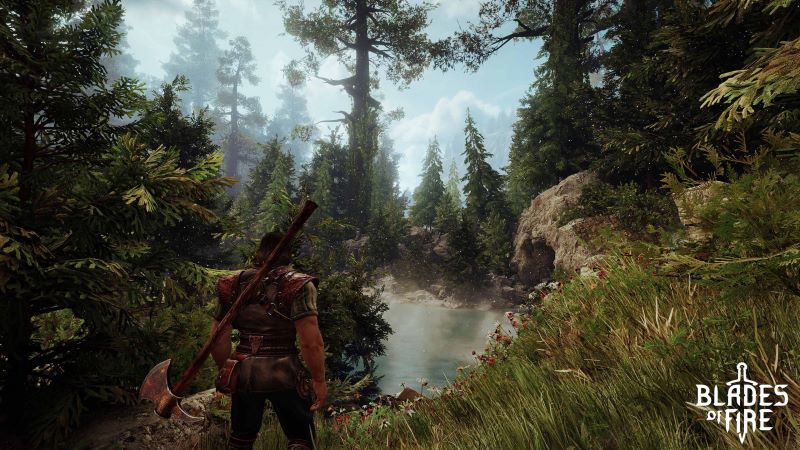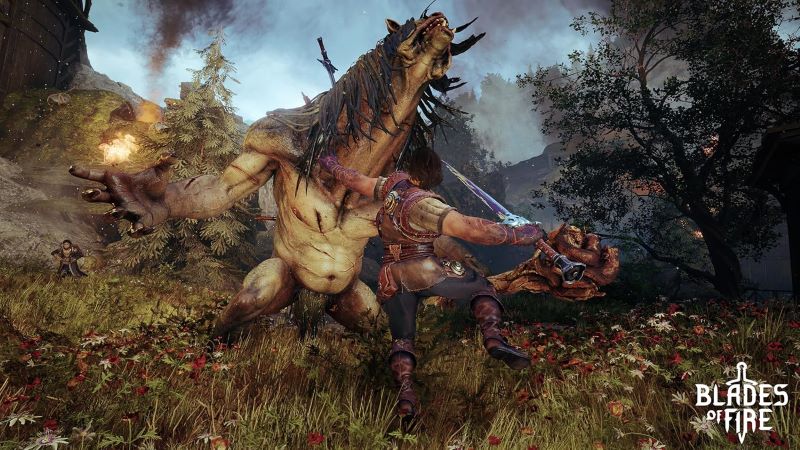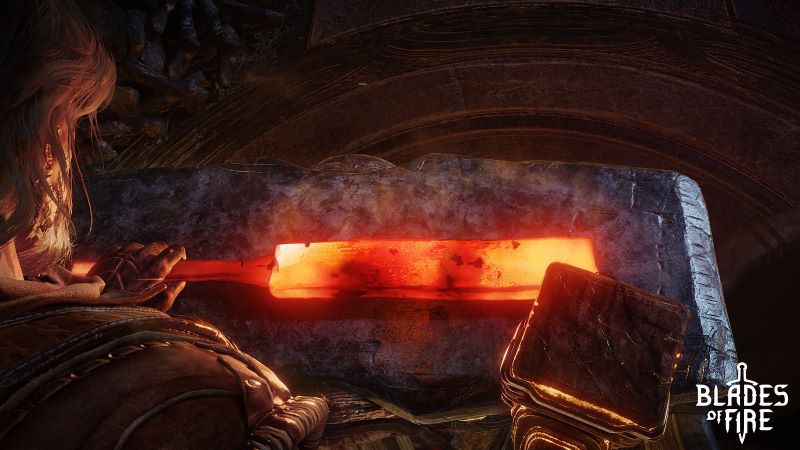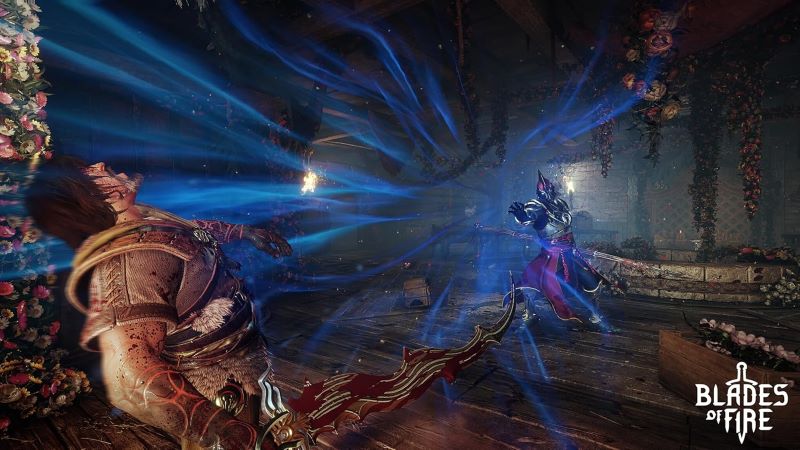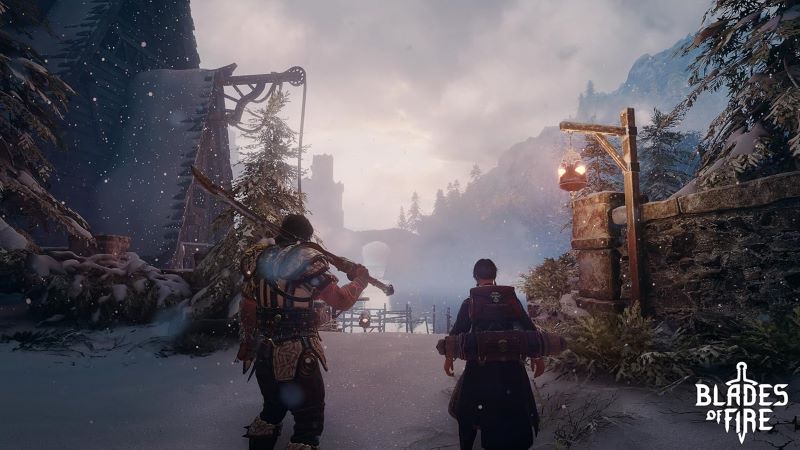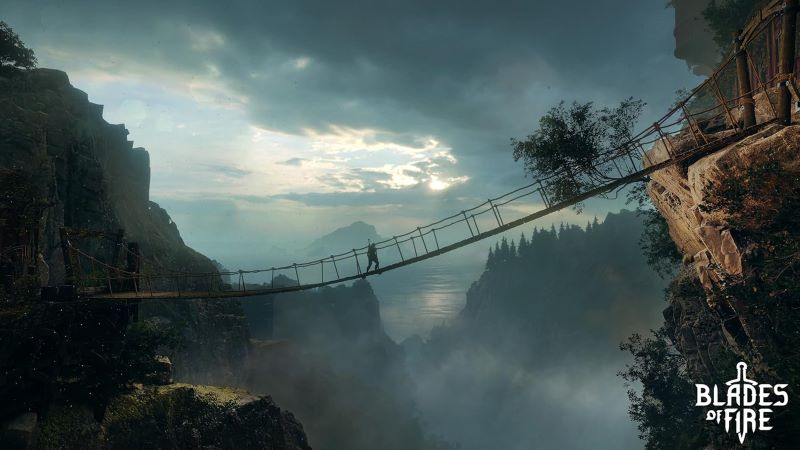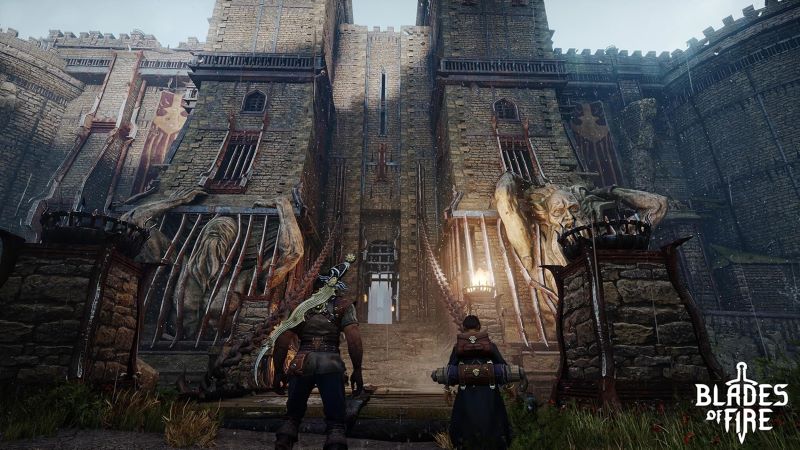Blades of Fire PS5 Review. It’s been a long journey for MercurySteam since the release of Castlevania: Lords of Shadow 2. MercurySteam partnered with Nintendo to deliver a new installment of the Metroid franchise after its release, and after eleven years, the studio has returned to the action-adventure genre with Blades of Fire. Unfortunately, their ambitious return doesn’t reach the ambitions I had hoped for.
Blades of Fire PS5 Review
A Grand Journey That Seems A Little Silly At The Start
Blades of Fire follows the adventures of Aran and Adso as they set off on a quest to kill the Queen. The Queen has cursed the world by turning steel to stone, leaving it usable only to her forces. It sounds like a silly concept for a story, but it involves ancient blacksmiths who used seven magical hammers to craft the entire world.
At the start of the adventure, Aran acquires the last of the seven hammers and gains the ability to craft steel weapons. The story itself doesn’t offer much to be excited about until you get past the halfway point, and the third and final act of the game is where a lot of the story comes to fruition as we learn about Aran and his connection to the Queen.
This is where the story shines a lot more, and it should have been presented throughout the experience. Throughout their adventure, Aran and Adso encounter unique characters who help them on their journey.
A Story Worth Sticking Around For
An old spirit that follows them throughout an entire region, revealing secrets. Another region sees an Ogre Emperor who asks for your help to regain his kingdom. These characters are a great addition, but don’t add anything to the main story. They are only present in one region where you encounter them.
It’s a shame they don’t stick around longer, as they add much character to a bleak world. Aran and Adso’s relationship is a solid one. MercurySteam clearly took a lot of inspiration from God of War. Though the two bicker a lot, they know each other’s usefulness.
Adso knows about the world and is constantly educating Aran in each region. He also takes notes on the enemies you’re fighting, and as you defeat them, he adds more and more knowledge about them from their weaknesses and strengths, which helps during combat if you take the time to read what he has to say.
Brutal Situations Hold Back Unique Combat
Combat is where the game falters the most. Blades of Fire tries a unique combat system that is great in concept and execution, but doesn’t deliver on its distinctive style here. Each attack is mapped to your four face buttons: Square, Triangle, Circle, and Cross.
If you press the Triangle button, you perform an overhead attack. The Square button swings your weapon to the right, targeting the enemy’s right arm.
Enemies have various weaknesses; even the same type of enemy can have armor on multiple parts of its body. When locking onto an enemy, a colored silhouette will appear over them. Whatever parts of their body are highlighted in green means that’s the spot to strike for maximum damage.
Orange means they take damage, but at the cost of weapon durability, while Red means your attack bounces off them and does no harm.
Your Weapons And Targeting Are Keys To Success
This is the first concept of combat you must learn; the second is what type of damage the enemy is weak against. There are three types of attack damage: Slashing, Piercing, and Blunt. All enemies are weak to one or more of these attack types.
Another thing to consider is armor. If you are facing off against an enemy with armor, looking for parts of their body that may not have any armor is essential. It could be their right arm or head, and that’s the part you want to strike, even though their entire character may be weak to your weapon.
Combat, unfortunately, doesn’t fulfil the premise that it presents. The biggest issue is just how attack-spongy the enemies feel. Some enemies will go down after a few attacks, while others can take dozens of strikes before they go down, even if you do everything right.
There Is A Difference Between Challenging And Frustrating
The other issue is how relentless and outmatched you feel whenever you face off against your opponents. There would be times when you are faced with six or seven enemies simultaneously, each with varying weaknesses and strengths to your weapons.
You are trying to remove one enemy, but the others get in the way, and your attack bounces off them. Aran is also easily stunned by every attack, so if the enemy hits you first, they stagger you, the next enemy, the one after that, and so on, and you get rushed and bombarded with attacks.
At times, it became so unfair and frustrating that I almost threw my control against the war in complete frustration, as I felt the game wasn’t even giving me a winning chance.
The environment also affects your weapons, meaning they will get deflected if your sword hits the side of a wall or a tree. Something that the enemies aren’t affected by.
Craft Your Ultimate Weapon
Weapons and crafting weapons are the bread and butter of Blades of Fire. Crafting a weapon by adding various crafting materials to increase its damage and blocking power is one of the most critical aspects of the game. You don’t level up or unlock new abilities, and you don’t even get armor; it’s all about crafting weapons that fit the situation.
You’ll select the type of blade you want, from a curved or spiral blade, to the length of the handle and hilt. It’s not just damage you need to worry about, but how heavy the weapon is determines how much stamina it drains on usage and how quickly you’ll be able to swing the weapon.
I would say its durability and sharpness are also essential. If you constantly strike an enemy, the blade begins to dull out, and you won’t do as much damage, and eventually, it won’t hurt the enemy at all. This is why striking the open body parts rather than the armored ones is important.
Plenty Of Weapons To Try Out
Every strike on an enemy will also drain its durability. You may even get to the point where your blades will dull out before their durability gets too low, which means you have to repair the weapon or recycle it if you don’t have enough repair stars to fix it.
When you craft a weapon, you have to match up metal stacks to line up with the blade’s outline. You do this by moving around a cursor and increasing and decreasing these medal bars as you strike. Every quality star has a specific number of strikes you can land to craft it before you lose a star.
The goal is to craft a weapon as quickly as possible with the most stars to provide you with the most chances to repair the weapon.
Great Exploration Had Me Hunting For Every Side Path I Could
Exploration is easily the best part of Blades of Fire. The game is lengthy, and finishing it took me over 50 hours. You travel to three main zones, each providing different terrain and enemies to encounter. These locations are vast and feature plenty of hidden secrets to find.
Though the game gives you an objective, it doesn’t hold your hand, leading you to that objective or place a quest marker to indicate where you need to go. One moment in the game, I was tasked with finding four items to repair a statue.
I was told what these items are, and I got a hint about where to find them, but no marker as to where to go. Based on my experience of what I’ve seen in the game, I had to figure that out and follow the clues to the hints I was provided.
Collectibles Are Scattered All Over The World
I loved this type of questing as it felt more like an adventure than simply playing a game. However, it could sometimes get frustrating, especially when there are parts of the map you can’t get to but don’t know if you haven’t found the path to it or if it’s something locked until you acquire a specific key or story moment to access it.
There are hidden chests that hold health and stamina gems. Collecting four of a kind will increase your maximum health and stamina, and you can also unearth hidden paths that lead to weapon statues. For example, if you have a weapon that’s part of the weapon class, you can present that weapon to the statue to unlock new parts for crafting that specific weapon.
I loved exploring the game as it added a lot of context to the world. Finding secrets was also a joy, as the rewards for these secrets were always worth it.
Great Environments With Plenty of Visual Variety
Visually, the game looks solid with plenty of varied environments and some effects in regards to blood and the clashing of steel Character models come up a bit lacking in detail however – up close they have somewhat of a plastic look to them – bit the environments are a real treat for the eyes.
The sound design is a mixed bag. The attacks and weapon sounds are excellent, but the soundtrack leaves much to be desired. The ambient sound and folk music are wonderful, but the combat music sounds like something from three decades ago, and it never felt like it was putting me in a battling mood.
Voice acting is another weird thing to experience. At first, it was laughable and felt like a completely budget title, but after a while of listening to the performances, especially Aran and Aldo, the more I enjoyed their work. The rest of the cast, though, isn’t great.
Blades of Fire is an ambitious title from a studio that has proven itself in the past. Though I enjoyed most of the game, its most significant focal point is its unique combat. Still, it doesn’t live up to the mark due to its high difficulty and some unfair and overwhelming odds to overcome.
Blades of Fire is a decent return to the action-adventure genre for MercurySteam. Blades of Fire does a lot right in the exploration and crafting systems, but its combat is a letdown not because of its actual mechanics, but because of its execution. For those looking for something new and unique with a fantastic world and top-notch exploration, Blades of Fire is for you. Just be wary, it will cost you a trip to anger management.
Blades of Fire releases on PlayStation 5 on May 22, 2025.
Review code kindly provided by PR
